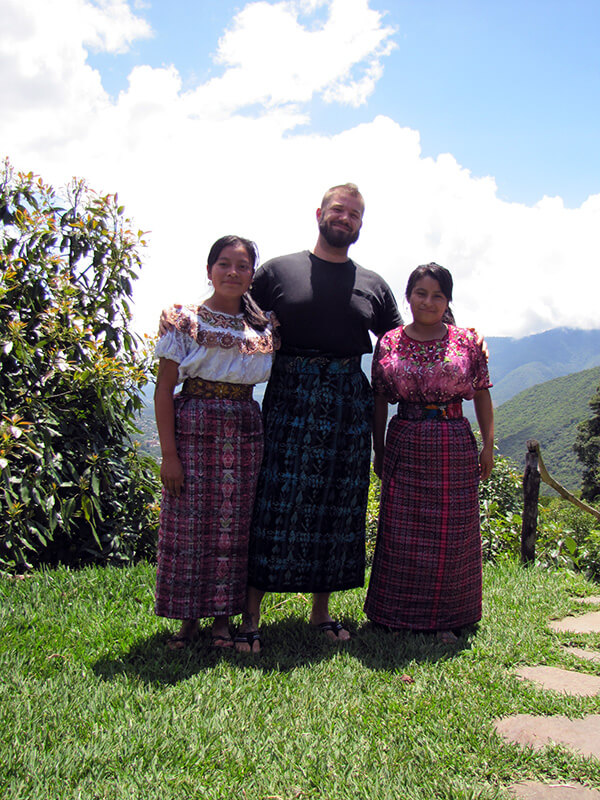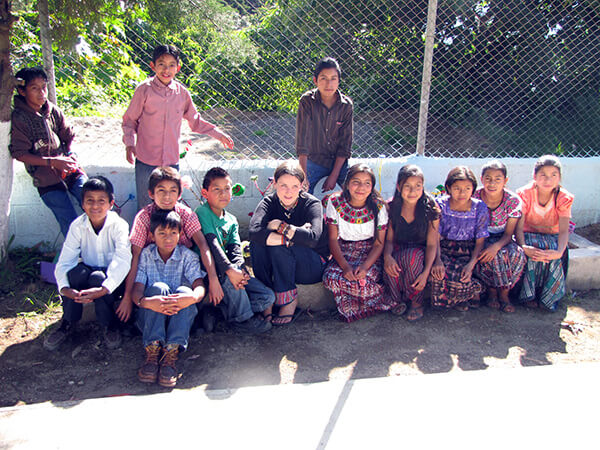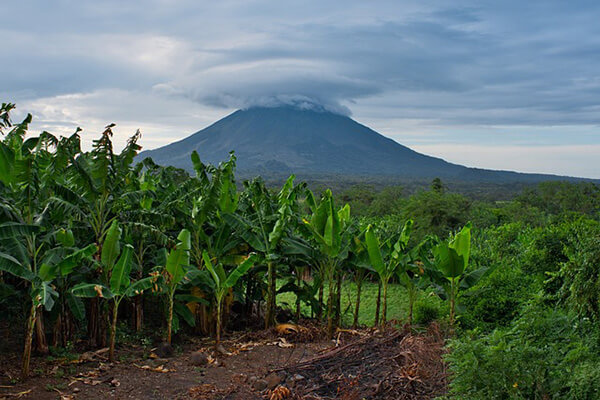How to Travel in Central America Long-Term
Article and photos by Jonathon Engels
Resources updated 2/12/2024 by Transitions Abroad

|
|
The author experienced an unexpected form of cultural exchange in Guatemala.
|
I first visited Guatemala in 2008. Having signed up to teach for eight months, from May to December, I planned to finish my contract and head down to South America. In February 2014, I finally reached Colombia. In my book, that’s long-term travel in Central America.
Truthfully, since 2008, I've lived in Guatemala on three different occasions, the original eight months, another year working for an NGO (Las Manos de Christine) in 2010-11, and then for a year-and-a-half (2012-2013) just existing from project to project. The point is that I loved the country so dearly that it took six years to leave, with the promise of returning.
It's important to keep in mind that Guatemala is the northernmost of the Central American countries.
Advice on Spending Meaningful Time in Guatemala
Guatemala's draw is so wonderfully diverse: 23 different languages, an incredible array of stunning landscapes, and centuries of culture — from ancient Maya civilizations to the modern Maya still walking around in traditional garb to crumbling colonial architecture to Garifuna. No less enticing is the very engaged and global expat community, the slew of NGOs involved in inspiring projects, and the seemingly infinite biodiversity. After nearly four years, I've still not seen everything I wish.
Luckily, it's an easy place to linger because of the list above of highlights and the many varied opportunities to work and volunteer. (Note: These suggestions apply to most of Central America.)
Luckily, it’s an easy place to linger, both because of the aforementioned list of highlights as well as the many varied opportunities to work and volunteer. (Note: These suggestions apply to most of Central America.)
-
Teaching English in Guatemala: Several language and international schools are operating throughout the country, and from my experience (I was the staff manager of Oxford Language Center in Antigua for eight months), they are usually looking for reliable teachers. Maximo Nivel, also in Antigua, aka the most beautiful town in Central America, offers quick TEFL certification courses if you need to be certified, and even promises job placement.
-
Volunteer with an NGO: Guatemala has many NGOs doing everything from eco-construction to fair trade to education. I started by helping part-time with a project called Safe Passage. That experience grew into a year-long contract to pilot a school program for Las Manos de Christine in the tiny village of Aldea El Hato.
-
Work-exchange with a Hostel: Many of the hostels in Guatemala offer work-exchange opportunities for travelers with flexible schedules. The deal is generally a few hours a day, working reception or bartending, in exchange for room and board. This makes staying as long as possible in any hot tourist spot possible. I "worked" for a mountain guesthouse called Earth Lodge for nearly two years. I couldn't bring myself to leave.

|
|
Children in Aldea El Hato, Guatemala, with the author's wife, the coach, in the center.
|
Beyond Guatemala
I could visit most of Central America during my various stays in Guatemala. Visas currently require that you leave the country every six months, so I wisely used this requirement as an invitation to see the rest of Central America. Before setting off on my quest to Colombia, I'd already been to Belize, Honduras, El Salvador, Costa Rica, and Panama, as well as the Yucatan and Chiapas in Mexico, both of which the likes of Lonely Planet likes to group as part of Central America. That left only Nicaragua.
So, in 2013, I decided it was time to officially go down south, and Nicaragua was the first scheduled stop. That was the easy part. The more difficult issue was my budget. While Guatemala is a lovely place to stay, there are better places to pad your pocketbook. Money was tight. I'd been able to get by on my wits (or, more likely, my contacts) in a country I was familiar with, but now a plan was in order. That plan turned out to be a website called HelpX.
HelpX is a website that lists volunteer opportunities for travelers. These postings are often work exchanges on organic farms but can also be volunteer spots for NGOs or short-term reception gigs at hostels. There are other sites, such as WWOOF and WorkAway, but HelpX was the cheapest option at €20 membership fee for two years and has worked like a charm.
HelpX Marks the Spot: Isla de Ometepe, Nicaragua

|
|
Lush Isla de Ometepe, Nicaragua, with volcano in background. Photo by Lukáš Jančička.
|
Of course, I took the chance to visit some Nicaraguan highlights on my trip down. However, most of my time in Nicaragua was spent on Ometepe Island, in the middle of Lake Nicaragua, the largest lake in Central America. HelpX had listed posts in other places – Leon, Granada, San Juan del Sur — but Ometepe was the attraction I most wanted to see. So, I signed up for a month volunteering in Nicaragua on an island-based farm at an eco-lodge called Totoco.
The owner-operator of Totoco Eco-Lodge, likes to describes it as a three-pronged project. The eco-hotel is a pretty expensive place but also "eco" enough to be waste-free, requiring guests to use composting toilets and rely on solar power. The Totoco Foundation is an NGO founded to help the surrounding community, including micro-financing, educational support, and medical upgrades. And there was the farm.
I had minimal experience working the soil, just some quick-run, hobby-like soirees into growing my herbs and salad. However, initiative and the will to try it goes a long way. My arrangement was room and board in exchange for five hours of work five days a week, helping to build a garden plot representative of what most Ometepe locals could have. It was a fun and also delicious project.
It was so fun that I stayed two months instead of one. About a week in, the owner announced he would return to Europe for a few weeks. Noting that I had no fixed schedule (and an exemplary work ethic), he asked if I'd mind staying on to help out while he was gone. So, I could housesit his sweet eco-pad and hang around the fancy hotel, with an infinity pool at my disposal, for six weeks. Budget travel in every possible way, with many perks.
There were several funny things I noticed in the cultural transition from Guatemala to Nicaragua:
-
Indigenous identity disappeared to some extent, such that specific everyday nuances I was used to seeing — baskets carried on heads, ladies slapping tortillas onto hot skillets, traditional clothing — were noticeably absent.
-
On the other hand, horses and carts reappeared as a viable mode of transportation; in general, farm animals seemed much more present on the streets. In rural areas, chickens and pigs were everywhere, so much so that they outnumbered street dogs.
-
Soccer gave way to baseball. My village on Ometepe had no soccer field around but two baseball diamonds. In Guatemala, my students had never put on a baseball glove.
Coasting Through Costa Rica

|
|
Local swimming hole in beautiful Costa Rica.
|
Before leaving Ometepe, I'd set up another farm, Vago's Place, on the Caribbean coast of Costa Rica. I gave myself a few days to travel and be an obligation-free tourist en route, stopping in La Fortuna near Volcan Arenal to relax in hot springs. I stayed in a hostel, at time, the best and only budget place. The staff helped me get by cheaply, including directions to a beautiful local swimming hole with a waterfall and the hidden locale of free natural hot springs. (Most hotels charge a small fortune for a soak.)
Then, it was on to Puerto Viejo de Talamanca.
Puerto Viejo is a classic beach town with a break that draws surfers, a significant Rastafarian presence, and a palm-lined seashore. My days at Vago's proved much more laborious than those at Totoco (a lot of digging up heavy soil), but there was the sea to enjoy in the afternoons. The Caribbean does wonders for washing away a day's labor. Plus, I spotted two sloths in the trees along the beach, a tree full of howler monkeys walking from the farm, and toucans atop the canopy.

|
|
One of three sloths, a unique species, spotted in trees while in Costa Rica. Look carefully to see the sloth.
|
Culturally, I noticed Costa Ricans have a much more developed concern for their environment. Famous for its ecotourism, the country as whole has seemed to get behind the no litter policy (something the rest of Central America is still working on) as well as moving largely into sustainability programs and nature reserves. And, it shows. The place is stunning, clean, and streamlined for tourism. It’s a different experience than the rest of Central America but still one worth having.
Traveling and "volunteering" in Costa Rica comes at a steeper price than the rest of Central America. Most listings for volunteer positions required at least a $10-a-night contribution in addition to toiling the land. While volunteering for a small fee made Costa Rica affordable, which many say it isn't, I'd grown accustomed to my non-existent Nicaraguan spending habits. Costa Rica warrants an asterisk for the ultra-budgeted: It's a must-see but requires a little of your savings.
The Panamanian Provision
By good fortune, I then managed to get a fantastic post in Panama: setting up a sustainable, organic garden on a waterfront property on Lake Gatun, formed by the building of the Panama Canal. On my previous visit to Panama, I'd already been to Bocas del Toro and Boquete in the north, which should not normally be skipped. So, I reduced my budget and headed straight to the new volunteer job.
Here's the beautiful thing: After three months of working my way down to Panama, I was already a month behind schedule but had acquired some decent skills and know-how regarding organic gardening and sustainable practices. The property owners, whom we've deemed Glenaven on the Lake, knew very little. So, they gave me free rein to explore and create whatever I wished, drawn from my new interests. My stay kept extending: two weeks to one month to six weeks and then…
Actually, the whole point of this venture was to finally get to South America, to my planned destination of Colombia. Well, I nearly didn't. The owners of Glenaven on the Lake were so pleased with their new garden that they asked me to stay for the next six months to develop different permaculture and sustainable systems on their property. So, we struck a deal. Before settling in Panama for half a year, I needed two months to reach the continental country below known as Colombia. And they agreed, so I would return to Central America again.
Reaching Panama takes you full circle. Southern Mexico and Guatemala have many expats and a strong indigenous presence. It wanes a little in the middle and reappears with a vengeance in Panama. U.S. retirees have made a significant impact: There are fancy, planned developments up the Pacific coast from Panama City to overpriced farmers' markets in the northern interior at Boquete. But, in the far southern reaches, the Kuna Yala, an indigenous tribe that out-stubborn the U.S., still lives in their own self-governed province in one of the most beautiful stretches of the Caribbean.
* * *
When traveling long-term, be it meticulously planned or by the seat of the chicken bus, it's easy to get distracted with logistics: how to get from point A to point B and what to see here or there. But slow budget travel is a different experience. Schedules dissipate, and they never really work in Central America ultimately. There is time to procrastinate, and one can't help but learn what one needs to know along the way — the quickest route, the cheapest place, the best hike. Besides, plenty of people will be pleased to sell what is to see or pack one more into a shuttle bus to that next destination. All of that comes easily and relatively worry-free.
It's different from how to travel long-term in Central America. That bus passed by a long time ago. I'm still struggling with how to leave.
For me, it’s not so much how to travel long-term in Central America. That bus passed by along time ago. I’m still struggling with how to leave.

|
Jonathon
Engels earned an MFA in creative writing. He has lived, worked, and/or volunteered in seven countries, traveling through nearly 40 countries. His many interests include permaculture, veganism, and ways to live sustainably.
|
|
